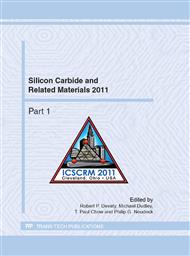p.549
p.553
p.557
p.561
p.565
p.569
p.573
p.577
p.581
GaAs Nanowires: A New Place to Explore Polytype Physics
Abstract:
Recently, polytypism has been observed in nanowires in materials, for which normally only one crystal structure is stable. For example, GaAs, nanowires can have wurtzite or mixed zincblende/wurtzite. Here we provide band structure parameters for wurzite and 4H GaAs and use them for modeling the nanowire electronic states. The band gap, crystal field splitting, and its strain dependence, as well as the effective mass parameters are calculated using the quasiparticle self-consistent GW method. The nanowire electronic states are obtained in the envelope function approximation within a simplified cylindrical model. The crystal field splitting of the wurtzite GaAs valence band is found to be 180 meV while in 4H-GaAs it is less than half 69 meV, suggesting a downward bowing as function of hexagonality. The conduction band minimum at Γ changes symmetry character under strain. We discuss the consequences for nanowires and determine the conditions under which a polarization reversal of photoluminescence can occur from mostly perpendicular to parallel to the wire.
Info:
Periodical:
Pages:
565-568
Citation:
Online since:
May 2012
Keywords:
Price:
Сopyright:
© 2012 Trans Tech Publications Ltd. All Rights Reserved
Share:
Citation:


